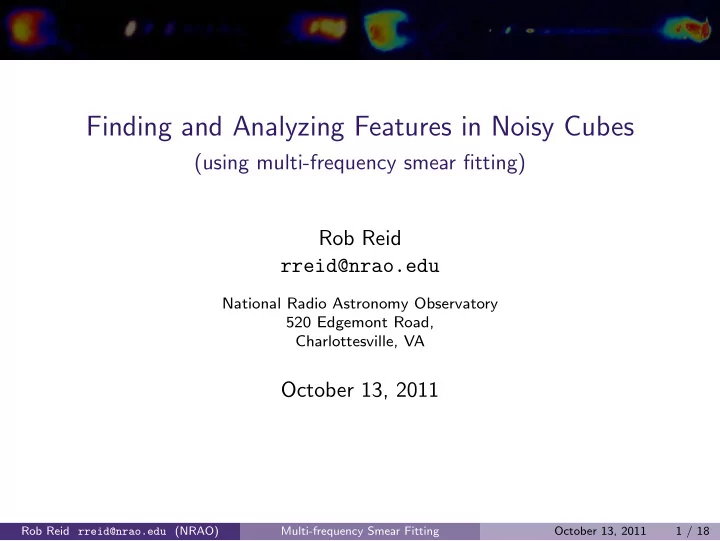

Finding and Analyzing Features in Noisy Cubes (using multi-frequency smear fitting) Rob Reid rreid@nrao.edu National Radio Astronomy Observatory 520 Edgemont Road, Charlottesville, VA October 13, 2011 Rob Reid rreid@nrao.edu (NRAO) Multi-frequency Smear Fitting October 13, 2011 1 / 18
Acknowledgements P. Kronberg, Univ. of Toronto M. Shepherd, Caltech Rob Reid rreid@nrao.edu (NRAO) Multi-frequency Smear Fitting October 13, 2011 2 / 18
Smear Fitting A two step deconvolution method: 1 Fit a set of model components, typically several dozen elliptical gaussians, to the visibilities by minimizing χ 2 . 2 � V i − V model ( � u i ; � p ) � χ 2 = � � � � � σ i � � i ( � u i = the i th baseline and � p = the parameter set) 2 Bias the model to broaden each component to account for the uncertainty of the intensity distribution. (Let χ 2 go up by approximately the number of degrees of freedom.) Implemented as a patch to difmap. It is not in CASA. Rob Reid rreid@nrao.edu (NRAO) Multi-frequency Smear Fitting October 13, 2011 3 / 18
Model Construction ...the harder and more interesting step. The good Different functional types (Gaussians, uniform disks, optically thin ellipsoids, etc.) can be mixed and matched. The bad Typically we don’t know a priori how many components of each type to use. The goal* Use as few parameters as necessary. * Maximum Entropy uses many more parameters (pixels) than measurements, but uses regularization to bring down the effective amount of info being claimed beyond some prior. Rob Reid rreid@nrao.edu (NRAO) Multi-frequency Smear Fitting October 13, 2011 4 / 18
Model Construction Heuristics are necessary (a consequence of incomplete and noisy sampling for any deconvolution method), but : they can be (and have been) scripted, (although some are implemented as new “tools”) and so far there has been no need to specify clean boxes or scales. Rob Reid rreid@nrao.edu (NRAO) Multi-frequency Smear Fitting October 13, 2011 5 / 18
Model Construction Many of smear fitting’s heuristics are mainly aimed at speeding up model construction. Don’t do global fits when they aren’t necessary. Don’t directly fit to the visibilities when it isn’t necessary. (Like minor and major cycles in clean.) It can blend smoothly with clean. Rob Reid rreid@nrao.edu (NRAO) Multi-frequency Smear Fitting October 13, 2011 6 / 18
Multifrequency Smear Fitting 2 � V i − V model ( � u , ν ; � p ) � χ 2 = � � � � � � σ i � � i ν vs. 2 � � V i − V ν, model ( � u ; � p ) � � � � = � � σ i � � i ν Rob Reid rreid@nrao.edu (NRAO) Multi-frequency Smear Fitting October 13, 2011 7 / 18
A combined 5 and 8 GHz VLA image Rob Reid rreid@nrao.edu (NRAO) Multi-frequency Smear Fitting October 13, 2011 8 / 18
One Size Does Not Fit All VLA A Array VLA D Array ← CLEAN → True image ← Smear fitted → Rob Reid rreid@nrao.edu (NRAO) Multi-frequency Smear Fitting October 13, 2011 9 / 18
Smear fitting Unsmeared Smeared A small(er) set of extended com- Custom smoothing instead of one ponents instead of 1000’s of δ size fits all or total entropy. functions, or 10 6 ’s of pixels. Rob Reid rreid@nrao.edu (NRAO) Multi-frequency Smear Fitting October 13, 2011 10 / 18
A peek at the uv plane ... Rob Reid rreid@nrao.edu (NRAO) Multi-frequency Smear Fitting October 13, 2011 11 / 18
Aren’t pixels more flexible? Maximum Entropy, CLEAN, and NNLS already semiautomatically produce models but pixels are rather anonymous, one size does not fit all, and selfcalibration needs to be worked in, too. Rob Reid rreid@nrao.edu (NRAO) Multi-frequency Smear Fitting October 13, 2011 12 / 18
Incorporating Physical Insight You may have good reason to allow different functions... Data courtesy of E. Seaquist. Rob Reid rreid@nrao.edu (NRAO) Multi-frequency Smear Fitting October 13, 2011 13 / 18
Receiving Physical Insight (...or at least publishing a little sooner.) Fitting the model for deconvolution also produces the values (optionally with uncertainties) of potentially interesting parameters. Smearing Beam Flux Radius θ Major Axis Axial Ratio φ Major Axis Axial Ratio φ (mJy) (mas) ( ◦ ) (mas) ( ◦ ) (mas) ( ◦ ) 49 . 74 151 . 44 154 . 63 178 . 3 0 . 3713 54 . 88 28 . 0 0 . 6682 66 . 87 60 . 30 135 . 08 63 . 04 219 . 5 0 . 4656 − 29 . 75 35 . 4 0 . 7553 − 30 . 43 43 . 54 126 . 11 − 131 . 21 135 . 8 0 . 4981 − 50 . 51 25 . 7 0 . 7641 − 60 . 96 55 . 56 119 . 32 − 37 . 60 132 . 9 0 . 8316 81 . 56 22 . 6 0 . 9544 − 133 . 90 Table 1: Winning lottery numbers Rob Reid rreid@nrao.edu (NRAO) Multi-frequency Smear Fitting October 13, 2011 14 / 18
Expanding Shells Rob Reid rreid@nrao.edu (NRAO) Multi-frequency Smear Fitting October 13, 2011 15 / 18
Spiral Galaxies There already are tilted ring model fitters, TiRiFiC, http://www.astro.uni-bonn.de/~gjozsa/tirific.html (G. Jozsa et al) Rob Reid rreid@nrao.edu (NRAO) Multi-frequency Smear Fitting October 13, 2011 16 / 18
Spiral Galaxies The Fourier transform of a line segment is just a sinc. Rob Reid rreid@nrao.edu (NRAO) Multi-frequency Smear Fitting October 13, 2011 17 / 18
Summary Model fitting is a particularly powerful way to combine data from multiple frequencies. Smear fitting does both deconvolution and model fitting. http://www.cv.nrao.edu/~rreid/smerf/ Rob Reid rreid@nrao.edu (NRAO) Multi-frequency Smear Fitting October 13, 2011 18 / 18
Recommend
More recommend